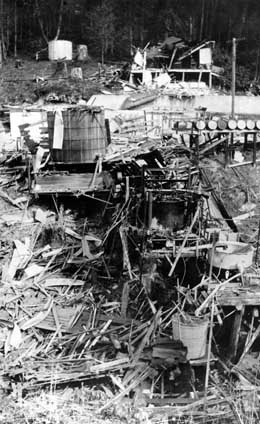On September 17, 1930, two explosions destroy the Puget Sound and Alaska Powder Company, a gunpowder plant located in a gulch about four miles southwest of Everett. Miraculously there are no deaths. Three workers are on duty at the time of the explosion and all manage to escape without serious injury. The explosions are felt by residents as far away as downtown Everett. Many homes in the surrounding area are destroyed and losses are not recoverable since homeowners are uninsured against explosions. The impact shatters windows in houses near the plant and eight residents are injured from broken glass.
Firefighters quickly report to the scene, fearing the worst as fire advances toward the plant's main explosive storage area. They succeed in containing it. Train and telephone services are temporarily halted, and curious residents jam Mukilteo Boulevard hoping to get a glimpse of the devastation.
The last worker to leave the plant before the explosion was Clarence Newman (1902-1978), who told his story. The fire began in the ammonium drying house. Plant manager W. E. Crosby had previously instructed workers to screen and reuse the ammonium in order to save costs. September 17th was a busy day at the plant, and waste had accumulated for hours, drawing moisture. In cleaning up, Newman scraped the waste across a screen. The particles spontaneously combusted, setting off sparks. The only water supply was Powder Mill Creek. Newman attempted to extinguish the fire. Realizing he couldn't, he warned the other two workers and all were able to escape without injury. When the fire reached the nitroglycerin house, it exploded.
The Puget Sound and Alaska Powder Company was one of two gunpowder manufacturers in Snohomish County at the time of the explosion, and the plant employed 30-40 men. Damage to the powder mill was estimated at a quarter of a million dollars. The explosion completely destroyed the plant. It was never rebuilt.

